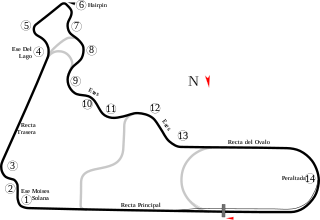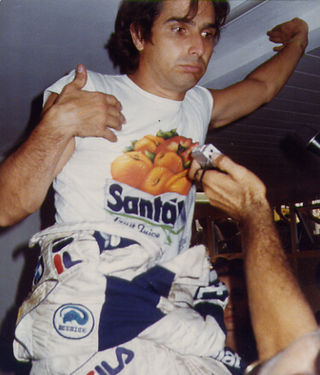
The 1987 Brazilian Grand Prix was a Formula One motor race held on 12 April 1987 at the Jacarepaguá Circuit in Rio de Janeiro. The race, contested over 61 laps, was the sixteenth Brazilian Grand Prix and the eighth to be held at Jacarepaguá, and the first race of the 1987 Formula One season.

The 1987 San Marino Grand Prix was a Formula One motor race held on 3 May 1987 at the Autodromo Dino Ferrari, Imola. It was the second race of the 1987 Formula One season. It was the seventh San Marino Grand Prix and it was held over 59 laps of the five kilometre circuit for a race distance of 297 kilometres.

The 1987 British Grand Prix was a Formula One motor race held on 12 July 1987 at the Silverstone Circuit, Silverstone. It was the seventh race of the 1987 Formula One World Championship. It was the 42nd British Grand Prix and the 23rd to be held at Silverstone. The race was held over 65 laps of the 4.78-kilometre (2.97 mi) circuit for race distance of 311 kilometres (193 mi).

The 1987 Japanese Grand Prix was a Formula One motor race held at Suzuka on 1 November 1987. It was the fifteenth and penultimate race of the 1987 Formula One World Championship.

The 1988 Brazilian Grand Prix was a Formula One motor race held on April 3, 1988, at the renamed Autódromo Internacional Nelson Piquet in Rio de Janeiro. Following his 3rd World Drivers' Championship in 1987 the Jacarepaguá Circuit was named after local hero Nelson Piquet. It was the first race of the 1988 Formula One season.

The 1988 Mexican Grand Prix was a Formula One motor race held on 29 May 1988 at the Autódromo Hermanos Rodríguez, Mexico City. It was the fourth race of the 1988 Formula One World Championship. The 67-lap race was won by Alain Prost, driving a McLaren-Honda, with teammate Ayrton Senna second and Gerhard Berger third in a Ferrari.

The 1988 Italian Grand Prix was a Formula One motor race held on 11 September 1988 at the Autodromo Nazionale di Monza, Monza. It was the twelfth race of the 1988 season. It is often remembered for the first win and 1–2 finish for the Ferrari team after the death of team founder Enzo Ferrari, and as the only race of the 1988 season that was not won by McLaren-Honda. It is also the only Grand Prix in the 1988 season without a McLaren-Honda driver on the podium, as well as Ferrari's last win at Monza until 1996.

The 1988 Japanese Grand Prix was a Formula One motor race held at Suzuka Circuit on 30 October 1988. It was the fifteenth and penultimate race of the 1988 season.

The 1988 Australian Grand Prix was a Formula One motor race held at the Adelaide Street Circuit on 13 November 1988. It was the sixteenth and final race of the 1988 Formula One World Championship, and the last race for which turbocharged engines would be eligible until the 2014 Australian Grand Prix.

The 1990 FIA Formula One World Championship was the 44th season of FIA Formula One motor racing. It featured the 1990 Formula One World Championship for Drivers and the 1990 Formula One World Championship for Constructors, which were contested concurrently over a sixteen-race series that commenced on 11 March and ended on 4 November. Ayrton Senna won in controversial circumstances the Drivers' Championship for the second time, and McLaren-Honda won their third consecutive Constructors' Championship.

The 1988 FIA Formula One World Championship was the 42nd season of FIA Formula One motor racing. It featured the 1988 Formula One World Championship for Drivers and the 1988 Formula One World Championship for Constructors, which were contested concurrently over a sixteen-race series that commenced on 3 April and ended on 13 November. The World Championship for Drivers was won by Ayrton Senna, and the World Championship for Constructors by McLaren-Honda. Senna and McLaren teammate Alain Prost won fifteen of the sixteen races between them; the only race neither driver won was the Italian Grand Prix, where Ferrari's Gerhard Berger took an emotional victory four weeks after the death of team founder Enzo Ferrari. McLaren's win tally has only been bettered or equalled in seasons with more than sixteen races; their Constructors' Championship tally of 199 points, more than three times that of any other constructor, was also a record until 2002.

The 1987 FIA Formula One World Championship was the 41st season of FIA Formula One motor racing. It featured the 1987 Formula One World Championship for Drivers and the 1987 Formula One World Championship for Constructors, which were contested concurrently over a sixteen-race series that commenced on 12 April and ended on 15 November. The World Championship for Drivers was won by Nelson Piquet, and the World Championship for Constructors by Williams-Honda. The season also encompassed the Jim Clark Trophy and the Colin Chapman Trophy, which were respectively contested by drivers and constructors of Formula One cars powered by naturally aspirated engines.

Satoru Nakajima is a Japanese former racing driver. He is a five-time Japanese Top Formula champion, and was the first full-time Japanese Formula One driver. Accordingly, he is responsible for several firsts for Japanese drivers in Formula One, including being the first to score championship points, and being the first to record a fastest lap.
Team Lotus was the motorsport sister company of English sports car manufacturer Lotus Cars. The team ran cars in many motorsport categories including Formula One, Formula Two, Formula Ford, Formula Junior, IndyCar, and sports car racing. More than ten years after its last race, Team Lotus remained one of the most successful racing teams of all time, winning seven Formula One Constructors' titles, six Drivers' Championships, and the Indianapolis 500 in the United States between 1962 and 1978. Under the direction of founder and chief designer Colin Chapman, Lotus was responsible for many innovative and experimental developments in critical motorsport, in both technical and commercial arenas.

The Williams FW11 was a Formula One car designed by Frank Dernie as a serious challenger to McLaren and their MP4/2C car. The car took over from where the FW10 left off at the end of 1985, when that car won the last three races of the season.

The Lotus 99T is a Formula One car designed by Gérard Ducarouge for use by Lotus in the 1987 Formula One World Championship.

The Lotus 100T is a Formula One car designed by Gérard Ducarouge and Martin Ogilvie for Team Lotus, and used during the 1988 Formula One season. The 100T was an update of the previous Lotus 99T model; technically the car was virtually unchanged, except for the ditching of the active suspension for a conventional setup, and a redesigned nose and rear bodywork. The car was powered by the same, 640 bhp, 1.5L turbocharged Honda V6 engine that powered the McLaren team to 15 wins in 16 races in 1988. The car was driven by reigning World Champion Nelson Piquet, and Japanese driver Satoru Nakajima.

The Lotus 102 was a Formula One racing car designed by Lotus for use in the 1990 Formula One season and would eventually go on to compete in 37 races spanning three seasons from 1990 until 1992.
Gérard Ducarouge was a French Formula One car designer whose career in motorsport started in 1965 when he joined Equipe Matra Sports. His Matra MS80 car, entered by the privateer Matra International team of Ken Tyrrell, won both the Drivers' Championship and Constructors' Championship in the 1969 season. He also designed cars for Ligier and Lotus which won several races in the 1970s and 1980s.

The Williams FW12 was a Formula One racing car used by the Williams team for the 1988 season. An updated version, the FW12C, was used for 12 of the 16 races of the 1989 season. The FW12 was Williams's first naturally aspirated car since the FW08 and FW08C used in the 1982 and 1983 season.

















